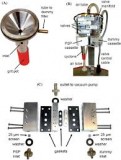
1. Sampler:
a. Filter: 5.0-µm pore size, polyvinyl chloride filter or equivalent hydrophobic membrane filter
supported by a cassette filter holder (preferably conductive).
b. Cyclone: 10-mm nylon(Mine Safety Appliance Co., Instrument Division, P. O. Box 427, Pittsburgh,
PA 15230), Higgins-Dewell(BGI Inc., 58 Guinan St., Waltham, MA 02154)[7], aluminum cyclone
(SKC Inc., 863 Valley View Road, Eighty Four, PA 15330), or equivalent.
2. Personal sampling pump, 1.7 L/min ± 5% for nylon cyclone, 2.2 L/min ± 5% for HD cyclone, or 2.5 L/min
± 5% for the Al cyclone with flexible connecting tubing.
NOTE: Pulsation in the pump flow must be within ± 20% of the mean flow.
3. Balance, analytical, with sensitivity of 0.001 mg.
4. Weights, NIST Class S-1.1, or ASTM Class 1.
5. Static neutralizer, e.g., Po-210; replace nine months after the production date.
6. Forceps (preferably nylon).
7. Environmental chamber or room for balance, e.g., 20 C ± 1 C and 50% ± 5% RH.
PREPARATION OF SAMPLERS BEFORE SAMPLING:
1. Equilibrate the filters in an environmentally controlled weighing area or chamber for at least 2 h.
2. Weigh the filters in an environmentally controlled area or chamber. Record the filter tare weight, W1
(mg).
a. Zero the balance before each weighing.
b. Handle the filter with forceps (nylon forceps if further analyses will be done).
c. Pass the filter over an anti-static radiation source. Repeat this step if filter does not release easily
from the forceps or if filter attracts balance pan. Static electricity can cause erroneous weight
readings.
3. Assemble the filters in the filter cassettes and close firmly so that leakage around the filter will not occur.
Place a plug in each opening of the filter cassette.
4. Remove the cyclone's grit cap before use and inspect the cyclone interior. If the inside is visibly scored,
discard this cyclone since the dust separation characteristics of the cyclone may be altered. Clean the
interior of the cyclone to prevent reentrainment of large particles.
5. Assemble the sampler head. Check alignment of filter holder and cyclone in the sampling head to
prevent leakage.
SAMPLING:
6. Calibrate each personal sampling pump to the appropriate flow rate with a representative sampler in line.
NOTE 1: Because of their inlet designs, nylon and aluminum cyclones are calibrated within a large
vessel with inlet and outlet ports. The inlet is connected to a calibrator (e.g., a bubble
meter). The cyclone outlet is connected to the outlet port within the vessel, and the vessel
outlet is attached to the pump. See APPENDIX for alternate calibration procedure. (The
calibrator can be connected directly to the HD cyclone.)
NOTE 2: Even if the flowrate shifts by a known amount between calibration and use, the nominal
flowrates are used for concentration calculation because of a self-correction feature of the
cyclones.
7. Sample 45 min to 8 h. Do not exceed 2 mg dust loading on the filter. Take 2 to 4 replicate samples for
each batch of field samples for quality assurance on the sampling procedure (see Step 10).
NOTE : Do not allow the sampler assembly to be inverted at any time. Turning the cyclone to
anything more than a horizontal orientation may deposit oversized material from the cyclone
body onto the filter.